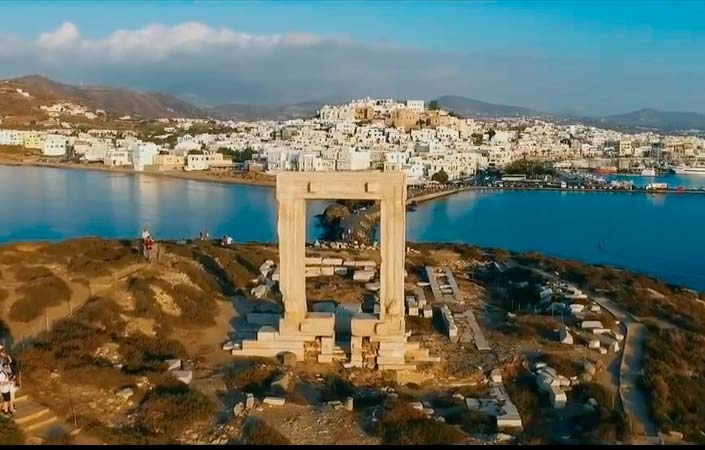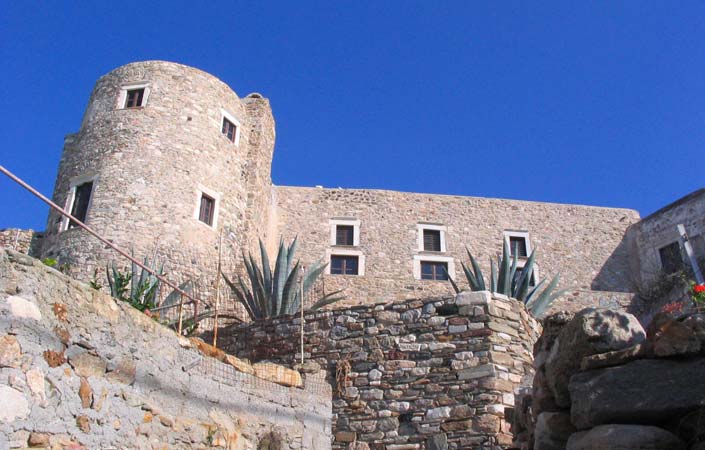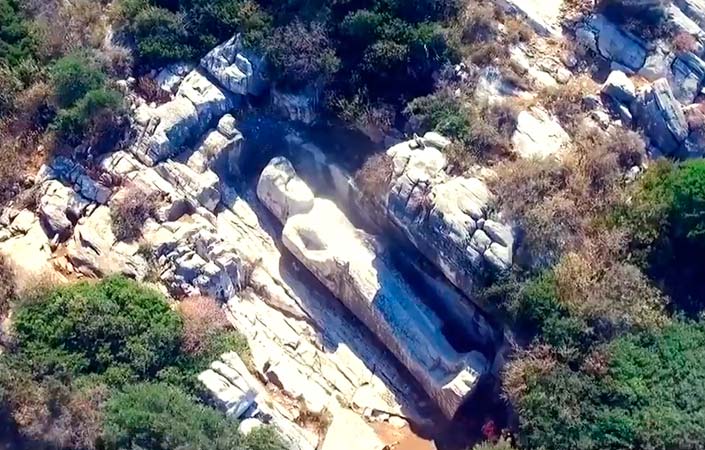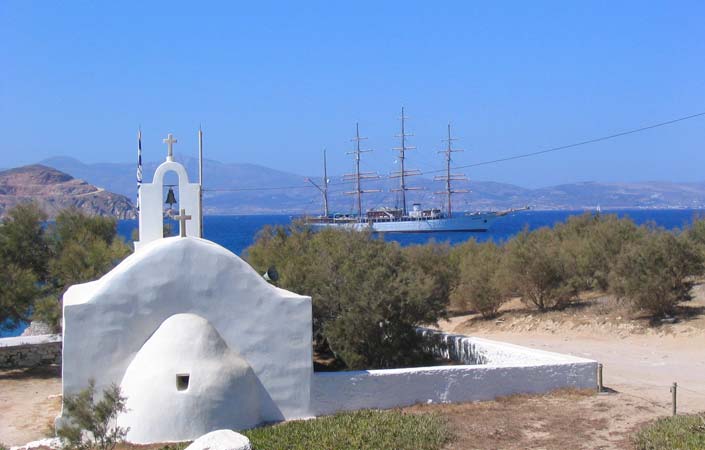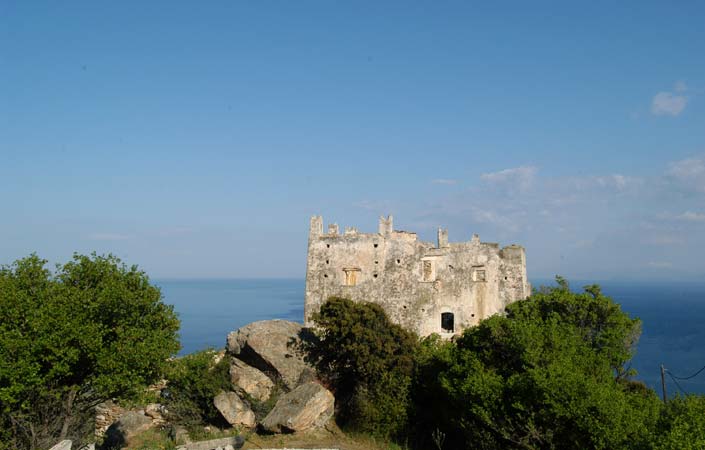Naxos Sights
On entering the harbor your attention is caught by Portara, the chapel of Our Lady “Mirtidiotissa” and the castle.
“Portara” the big marble gate is what the remains of the ancient temple of Apollo that was standing here. The ruins of the temple are called “Palace” implying the palaces of Ligdamis the ancient tyrant of Naxos (6th century BC). The legend says that here Theseus abandoned Ariadne when he came back from Crete.
High on the hillside of Chora stands the Venetian castle that was fortified with 12 towers. It was built in 1207. Its main buildings are the Tower of Sanoudos, the Catholic Metropolis, the Jesuit monastery (French commercial school), the Ursulines monastery, and the Capuchin monastery. The castle with its mansions is decorated with crests of Venetian rulers and is inhabited contiguously since 1207. There you can also see the archaeological museum with its famous Cycladic idols and the Naxos Archive with rare manuscripts.
Some of the most beautiful monuments are from the Byzantine period: Gorgeous churches that you can see all over in villages, mountains and the countryside.
In the monastery Virgin Drosiani you can see the older wall paintings in the Balkans. Our Lady “Protothroni” in Chalki and St. George “Diasoritis” is similar in history and beauty.
St. Mamas in Potamia is the local saint, protector of the shepherds. Here you will see another Byzantine monument of the 9th century.
Churches and country chapels are all over Naxos with various architectural styles. Especially interesting are the monasteries that look like fortresses and their towers who have several styles like archaic, monastic, Byzantine, medieval and Hellenistic too!
The monastery of Photodoti in Danako is the oldest monastery on the island and looks like a tower from a fairy tale. Our Lady the Highest in Egares, the tower of Himaros (4th century) is one of the most important monuments in Naxos, circular, with four floors, build with local marble, the tower of Agia e.t.c.
The ancient inhabitants of Naxos build many castles in which people continued to live in the Byzantine era and in the Venetian domination. The castle of Apalirou, the Upper castle, the castle of Sanoudou, Klaogeros and more.
On the foothills of the Upper Castle, in Tragea, is a graveyard of Geometric times in which circular graves were discovered (Homeric Era) with very important findings.
In Naxos you will see temples that used to be places of worship for Jupiter, Dionysus and Demetra.
Jupiter was raised in Naxos in the cave of Za and was worshiped as a protector of the sheep.
In a field in Livadia the sanctum of Dionysus was found in Iria (the older structure in Cyclades). In Giroula near Sagri village is the marble temple dedicated to Apollo and Demetra, one of the best preserved archaic buildings.
In the years of its great prosperity (7th – 6th century BC), Naxos was the dominator in Cyclades. Projects of the people of Naxos of this era are the temple of Apollo and the lions of Delos. Of the same era is the half-finished Kouros (young man s statue) in Melanes at the site of Flerio. A stony mass with a broken leg, that rests for centuries between the waters the sycamores and the rosebays.
On the northern part of the island is another Kouros laying down in an ancient quarry. It represents Dionysus and its length is more than 10 meters.
Ιστορία
Η Νάξος πρωτοκατοικήθηκε σύμφωνα με την παράδοση από Θράκες που έφεραν στο νησί και τη λατρεία του θεού Διόνυσου. Αυτούς που διαδέχθηκαν Κάρες και Ίωνες. Υπήρξε κέντρο του Κυκλαδικού πολιτισμού (3200-2100 π.Χ.), όπως έδειξαν τα πλούσια ευρήματα των ανασκαφών (Γκρότα), ήταν κατοικημένη στα Μυκηναϊκά χρόνια (Απλώματα) και με την αποίκηση των Ιώνων (1000 π.Χ. περίπου) γνώρισε μια νέα περίοδο ακμής, που κορυφώθηκε τον 7ο και 6ο π.Χ. αι. Στους Περσικούς πολέμους τάχθηκε εναντίον των Περσών, έγινε μέλος της Αθηναϊκής συμμαχίας και στη συνέχεια πέρασε στους Μακεδόνες, τους Πτολεμαίους της Αιγύπτου, τους Ροδίους και τέλος στους Ρωμαίους. Τη Βυζαντινή περίοδο δέχτηκε πολλές πειρατικές επιδρομές με αποτέλεσμα οι κάτοικοι να τραβηχτούν στο εσωτερικό και να ιδρύσουν οικισμούς για την προστασία των οποίων έχτισαν πύργους, από όπου αντιμετώπιζαν τους επιδρομείς .Το 1207 ο ενετός Μάρκος Σανούδος κατέλαβε το νησί και το έκανε έδρα του Δουκάτου του (Δουκάτου της Νάξου ή του Αρχιπελάγους). Το 1537 λεηλατήθηκε από τον Μπαρμπαρόσα και το 1566-1579 ανήκε στον Ιωσήφ Ναζή. Στη συνέχεια κατακτήθηκε από τους Τούρκους και το 1830 απελευθερώθηκε με τις υπόλοιπες Κυκλάδες.
